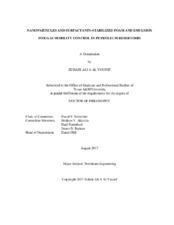| dc.description.abstract | This work proposes the use of nanoparticles (NPs) to stabilize foams/emulsions for gas mobility control and to improve the gas sweep efficiency. First, NPs were used alone to stabilize emulsion. Second, NPs and surfactants were used synergistically to improve the stability of foam.
Surface modified silica NPs with DCDMS, hidden chemical, and PEG were used to assess the ability of NPs to stabilize gas-liquid emulsions at reservoir conditions. Silica modified with DCDMS was able to increase the CO2 viscosity 26-60 fold. Silica modified with hidden chemical was able to increase the CO2 viscosity 25-53 fold and N2 viscosity 22-54 fold. Finally, the presence of silica modified with PEG was able to increase the CO2 viscosity 24-49 fold. All tested materials showed an inverse relationship between the emulsion quality and viscosity. In most cases, salinity was found to have a significant impact on emulsion strength. As salinity increased, the emulsion viscosity increased, too. The concentration of NPs showed similar behavior, with NPs concentration and viscosity being directly proportional. Shear rate was found to be a crucial parameter for emulsion stability and viscosity, with a threshold shear rate being necessary to stabilize emulsions. Also, increased pressure can improve emulsion stability to produce a more viscous emulsion.
The presence of NPs in all surfactant solutions enhanced foam stability and produced more viscous foams compared to surfactant alone. The presence of NPs with ENORDET A031 was able to increase the gas MRF up to 84.57 compared to 72.57 for surfactant. For the mixtures of silica NPs and nonionic surfactants, results showed that the concentration of surfactant and NPs is a crucial parameter for foam stability and that there is an optimum concentration for strong foam production. For N2 foam, the mixture of surface modified silica NPs and CNF surfactant resulted in a total recovery of 49.05% compared to 41.45% for surfactant alone. The total oil recovery for the same mixture with sc-CO2 was 80.05% of the OOIP. This is around 4% higher than the surfactant case and 8.55% higher than sc-CO2. In fractured rocks, oil recoveries during secondary production mechanisms for the mixture of surface modified silica NPs and CNF surfactant, the surfactant alone, and sc-CO2 alone were 12.62, 8.41 and 7.21% of the OOIP, respectively. | en |


